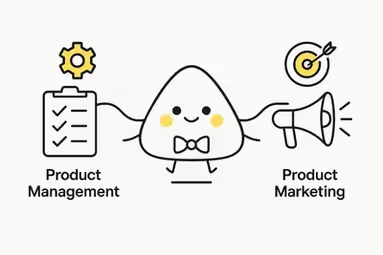.webp)
Product Management Strategy: How PM-Product Marketing Drives Success
Discover how effective product management strategy combined with product marketing creates winning products. Learn frameworks, case studies & actionable insights for PMs.

Product Management Strategy: How the PM-Product Marketing Partnership Drives Winning Products
Product managers face an alarming reality: 95% of new products fail within their first year, according to Harvard Business School research. In today's hyper-competitive landscape, even the most innovative features can disappear into obscurity without the right strategic approach. The solution lies not in isolated product development, but in the powerful synergy between effective product management strategy and product marketing.
Why Product Management Strategy Alone Isn't Enough
If product development were a high-performance vehicle, product management would be the engine—identifying market needs, defining strategy, and prioritizing features that drive the product forward. However, even the most powerful engine needs a skilled driver and navigation system to reach its destination.
This is where the critical gap emerges. Many product teams excel at building features but struggle with market positioning, user adoption, and sustainable growth. Research from Pragmatic Marketing shows that companies with aligned product management and marketing teams achieve 19% faster revenue growth and 15% higher profitability.
The Hidden Costs of Misalignment
When product management strategy operates in isolation from product marketing, several costly problems emerge:
- Feature adoption rates drop by 40% when new capabilities lack proper positioning
- Customer acquisition costs increase due to unclear value propositions
- Product-market fit becomes harder to achieve without coordinated market feedback loops
- Stakeholder management suffers from inconsistent messaging across teams
The Product Management Strategy Framework: Building Synergy
Successful product organizations implement a structured approach to align product management strategy with marketing efforts. Here's a proven framework for creating this essential partnership:
Phase 1: Shared Discovery and Customer Research
The foundation begins with collaborative customer research and product discovery processes. Both teams must participate in:
- User story mapping sessions that capture both functional requirements and emotional drivers
- Customer interview programs with shared insights and learnings
- Market analysis initiatives that inform both product roadmap planning and positioning strategies
Actionable Step: Establish bi-weekly cross-functional research reviews where product and marketing teams analyze user feedback, competitive intelligence, and market trends together.
Phase 2: Coordinated Product Roadmap Planning
Effective product roadmap planning requires marketing input from the earliest stages. This collaboration should include:
- Feature prioritization discussions that balance user needs with market positioning opportunities
- Launch timing coordination that maximizes market impact
- Success metrics alignment using OKRs for product teams that reflect both usage and business outcomes
Template: Create a shared roadmap document with columns for feature description, user value, marketing angle, and success metrics.
Phase 3: Integrated Go-to-Market Execution
The final phase transforms planning into results through coordinated execution:
- Product analytics sharing that informs marketing campaign optimization
- A/B testing collaboration on both product features and marketing messages
- Customer feedback loops that drive continuous product and positioning improvements
Case Study: How Spotify Masters Product Management Strategy
Spotify exemplifies world-class synergy between product management strategy and product marketing. Their approach demonstrates how coordinated teams can create both exceptional user experiences and viral market moments.
The Spotify Wrapped Success Formula
Spotify's annual Wrapped feature showcases the perfect marriage of product management strategy and marketing execution:
Product Management Excellence:
- Data-driven feature development using comprehensive user analytics
- Personalization algorithms that create unique value for each listener
- Seamless integration with core platform functionality
Product Marketing Mastery:
- Eye-catching visual design that encourages social sharing
- Strategic timing that maximizes year-end engagement
- Viral mechanics built into the core user experience
Results: Wrapped generates over 60 million social media shares annually and drives 20% of Spotify's new user acquisitions in December, according to industry reports.
Key Lessons from Spotify's Approach
- Shared Metrics Focus: Both teams optimize for engagement, retention, and viral coefficient
- Data-Informed Decision Making: Product analytics drive both feature development and marketing strategies
- User Experience Priority: Marketing amplifies great product experiences rather than masking poor ones
Implementing Product Management Strategy Best Practices
Step 1: Establish Cross-Functional Rituals
Create regular touchpoints between product management and marketing teams:
- Weekly alignment meetings for roadmap updates and market feedback
- Monthly strategy sessions for longer-term planning and goal setting
- Quarterly business reviews that evaluate combined team performance
Step 2: Develop Shared Success Metrics
Implement OKRs for product teams that reflect both product and marketing goals:
- Product adoption rates (tracking feature usage and engagement)
- Customer acquisition metrics (measuring marketing-driven growth)
- Revenue impact indicators (connecting product improvements to business outcomes)
Step 3: Create Communication Systems
Build information sharing processes that keep both teams aligned:
- Stakeholder management protocols for consistent external messaging
- Product backlog management that incorporates marketing insights
- Customer research databases accessible to both teams
Common Pitfalls in Product Management Strategy Integration
Avoiding the Silo Trap
Many organizations struggle with departmental boundaries that prevent effective collaboration. Warning signs include:
- Product roadmaps created without marketing input
- Marketing campaigns launched without product team awareness
- Customer feedback that doesn't flow between teams
Solution: Implement cross-functional project teams for major initiatives, ensuring both product and marketing perspectives inform decisions from the start.
Balancing Speed with Alignment
Agile product development can sometimes clash with marketing planning timelines. Address this through:
- Flexible planning frameworks that accommodate both sprint cycles and campaign schedules
- Progressive disclosure strategies that allow marketing preparation while development continues
- Minimum viable campaign approaches that match lean product development principles
Measuring Success: Key Performance Indicators
Track the effectiveness of your integrated product management strategy using these metrics:
Product Performance Indicators
- Feature adoption rates within 30/60/90 days of launch
- User engagement scores for new capabilities
- Customer satisfaction ratings for recent releases
Marketing Performance Indicators
- Campaign conversion rates for product-focused initiatives
- Social sharing and viral coefficient for product announcements
- Customer acquisition cost for product-led growth campaigns
Combined Success Metrics
- Product-market fit indicators (retention, NPS, usage patterns)
- Revenue per user improvements following major releases
- Market share growth in target segments
Transform Your Product Management Strategy Today
The evidence is clear: organizations that successfully integrate product management strategy with product marketing achieve superior results in user adoption, market penetration, and business growth. The question isn't whether to pursue this alignment, but how quickly you can implement it.
Ready to unlock the full potential of your product strategy? ProductPeople specializes in helping product management teams build these essential cross-functional partnerships. Our consultancy provides frameworks, training, and hands-on guidance to transform isolated product development into coordinated market success.
Contact ProductPeople today to discover how our product management strategy consulting can accelerate your team's performance and drive measurable business results.
FAQ
The biggest challenge is the lack of alignment between product management and product marketing. While product managers excel at building features, they often fail to position them correctly in the market. This misalignment leads to low feature adoption, increased customer acquisition costs, and poor product-market fit.
A strong partnership leads to significant business benefits. Companies with aligned teams see faster revenue growth, higher profitability, and improved feature adoption. This is because both teams work together to ensure that the product not only solves a user's need but is also communicated effectively to the right audience.
Product teams can build this partnership by creating a shared framework that includes: Shared Discovery: Conducting customer research and market analysis together. Coordinated Roadmap Planning: Involving marketing in feature prioritization and launch timing. Integrated Go-to-Market Execution: Sharing product analytics and collaborating on A/B tests.
A common pitfall is operating in silos, where each team works independently without sharing information. Other mistakes include creating product roadmaps without marketing input and launching campaigns without involving the product team. To avoid this, establish regular cross-functional meetings and shared communication systems.
Success can be measured by a combination of product and marketing metrics. Look at feature adoption rates, customer satisfaction, and user engagement on the product side. For marketing, track campaign conversion rates and social sharing. Combined metrics like product-market fit indicators (e.g., retention, NPS) and revenue growth are also critical.
Read More Posts
.webp)
Product Manager vs. Product Owner vs. Project Manager

Customer Interview Techniques for Better Product Decisions

How to Add Value in 2 Weeks: From Our Experience as Interim Product Managers

Introduction to Vibe Coding for Product Managers: From Idea to MVP

Communication Tips for Product Managers That Get Responses



